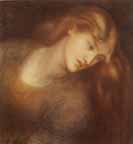
'Andromeda, by Perseus saved and wed,
Hankered each day to see the Gorgon's head:
Till o'er a fount he held it, bade her lean,
And mirrored in the wave was safely seen that death she lived by.
Let not thine eyes know
Any forbidden thing itself, although
It once should save as well as kill; but be
Its shadow upon life enough for thee.'
These lines that accompany Rossetti's unfinished painting, Aspecta Medusa, divide conceptually into two parts. The first half alludes directly to the story of Perseus and Andromeda; Perseus, who rescued Andromeda from the sea monster using the power of the head of the medusa as a weapon, now satifies Andromeda's desire to see the instrument which granted her freedom by allowing her to view it safely as a reflection in the water.
Both female characters, Andromeda and Medusa, are controlled by the male Perseus; he allows Andromeda to look into the water and indulges her overwhelming curiosity, and he asserts ultimate control over Medusa in taking her life. Perseus even wields the mighty feminine power of the Gorgon's head when he employs it to slay the sea monster. Female power, in this poem, is dissipated through the male hero, and Rossetti equates female curiosity and desire with danger.
What Rossetti treats allegorically in the first stanza, he treats literally in the second, as the focus shifts from the classical tale to a direct moral lesson. Indeed, the instructive tone of the words, "Let not thine eyes know/ Any forbidden thing itself" accentuates the message — that the hunger for knowledge is dangerous — by addressing the audience in the second person. Rossetti stresses the warning further through the compact description of "that death she lived by" — Rossetti seems, in fact, to superimpose life and death onto the image of Andromeda in one succinct phrase. Ultimately, through this tale of the Medusa's power, Rossetti underlines the assertion that curiosity for knowledge is punishable by death.
Discussion Questions
1. Rossetti depicts Perseus wielding the feminine transformative power of the Gorgon's head. Could this act of turning life into stone be a metaphor for art? What would support this reading?
2. In what way is it significant that artistic power is linked to a woman in such a reading?
3. Andromeda is not literally imprisoned, but in what ways is she figuratively imprisoned in this pooem?
4. Where else have we been introduced to the description of reflections as shadows, and what does this word choice achieve?
5. The painting was never finished because the representation of the severed head was not well received by the patron. How does the isolated figure of Andromeda compare to Rossetti's other portraits?
Last modified 27 June 2020